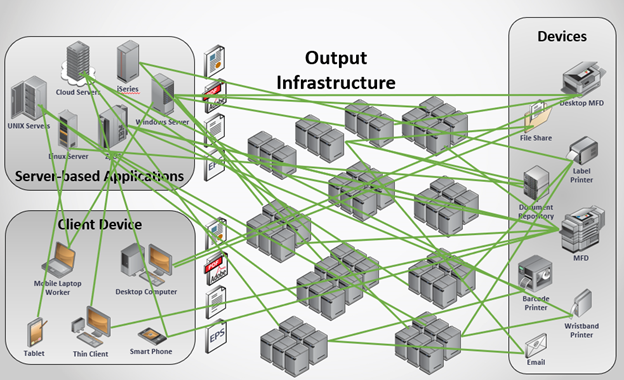Last week, my colleague Nebil explained why moving print and scan to the Cloud is not only a great idea but a business imperative. Now that we know we must move to the Cloud, we can simply go and do it, right? “It should be easy,” you’re thinking. While it certainly can be done without complications, there are several things to consider before jumping right into this transition. In this article, we will go over some things to consider beforehand to make things much smoother in the long run.
Consider some of the less apparent challenges, like the important documents that must keep flowing around your organization to support your day-to-day work processes. Thousands or possibly even 100,000’s of end user workstations need to be migrated before you can utilize your new Cloud print and scanning solution. Critical server-based applications in your organization need the ability to print or you risk document delays and outages no company can afford. Endpoint devices such as printers and scanners of numerous makes and models make things even more complicated. Connecting end user workstations to those printers/scanners often involves implementing infrastructure components such as Windows Print Servers. Depending on the size of your business, your environment might even look something like the image below:

As shown, a company can have many applications/workstations/mobile devices generating output that must be connected to the infrastructure that supports them. To handle this document volume, companies often stand up dozens or hundreds of servers. Next, every printer in your environment must be defined on these servers. Easy right? Actually, not so much when you consider one Windows Print Server can only support a few hundred printers. Since you have more than a few hundred printers, your team will need to go to each of these Windows Print Servers and define printers.
Eventually, your IT folks get all the printers defined and everything is up and running in production. At some point, they will get a call from an end user asking for help retrieving their document from a printer. Your team can’t remember which Windows Print Server this printer is defined to, so they must check all 40+ servers until they locate the one that corresponds to the affected printer. It’s bad enough when it’s your own staff managing the network, but things get even worse when a Managed Print Services provider is involved. The simplest tasks such as adding or moving a printer are overburdened by time consuming and expensive change control requests.
I think you’ll agree, traditional print architectures don’t quite cut it anymore. Old-style print architecture is going away, and more companies are moving to the Cloud every day. But how they make this change is important. You must avoid simply moving your current mess to the Cloud, as the resulting environment will be just as cumbersome and complicated as it was on-premise. Luckily for you, LRS has a solution.
Many companies are joining forces with LRS to offer an Enterprise-wide Cloud Print and Scan service. This not only provides a digital backbone, but also delivers a multi-vendor Print and Scan solution focused on security and reliability. One that eliminates the need to constantly update and support an inflexible and complicated IT Print and Scan infrastructure.
Providing your users Enterprise Cloud Print and Scan capabilities is easier than ever with the LRS solution, which leverages your organization’s connection to the Public Internet. LRS takes care of all the complications involved such as connectivity, secure authentication, and data encryption – all of which are a must in the industry today. By eliminating common points of failure and simplifying the IT environment, LRS software has helped many customers:
- Increase the efficiency of end users and administrators with intuitive user interfaces
- Reduce IT involvement in day-to-day Print and Scan administration tasks
- Establish a trusted service layer to handle document capture securely and reliably from any application or platform and delivery to any destination
The last of these points is perhaps the most important. As my colleague Nebil said, the ability to print any document/anytime/anywhere is great, but not if it comes at the expense of security.
Now that we have laid out the challenges you face today and the requirements for the future state of your organization’s Cloud Print and Scan solution, our next Blog article will tackle the biggest elephant in the room. How do we actually develop and deploy an Enterprise Cloud Print and Scan solution? Stay tuned.